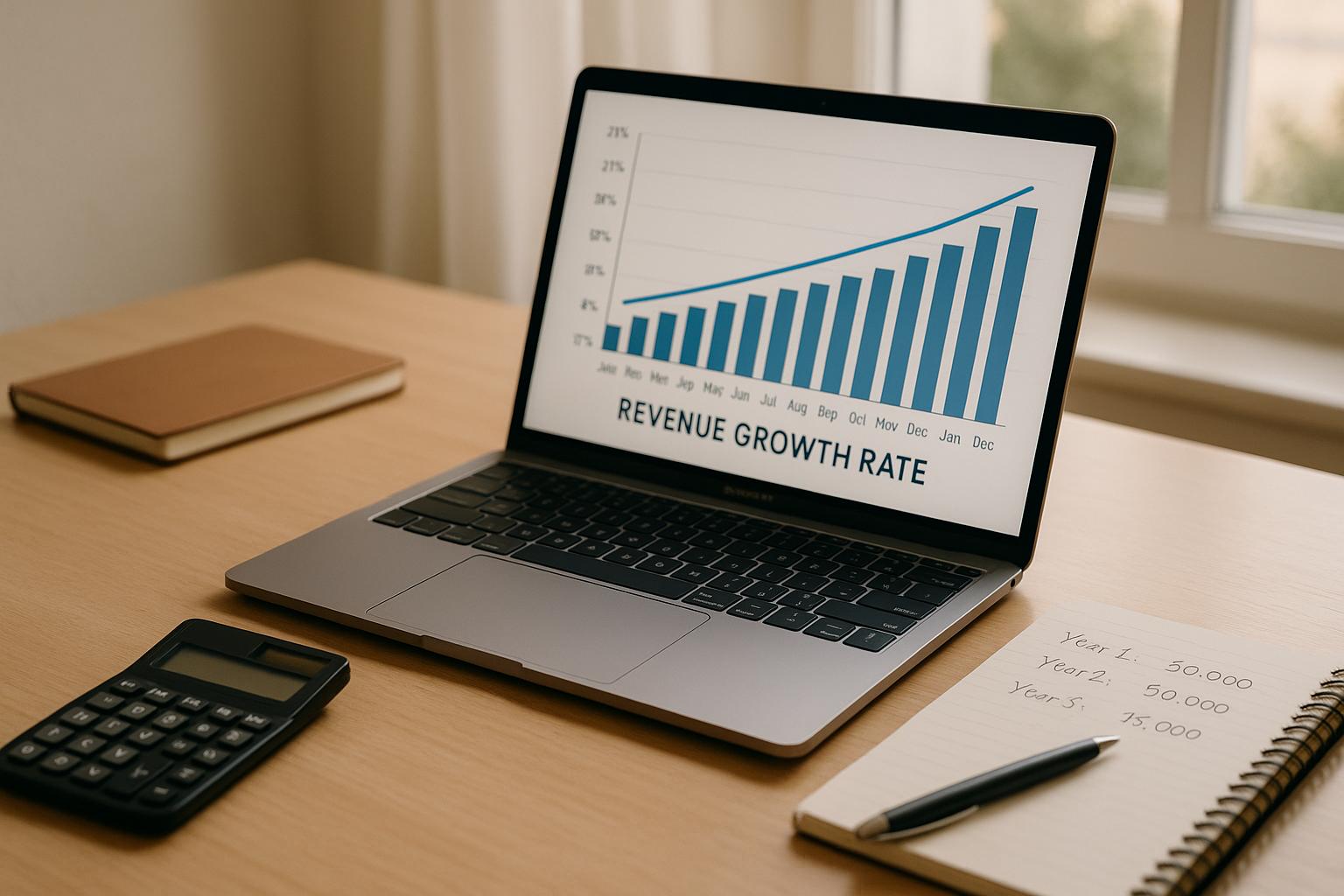Precedent Transaction Analysis for Private Companies

Precedent transaction analysis helps value private companies by examining real market deals from the past 3–5 years. It focuses on metrics like deal size, revenue, industry trends, and market conditions to establish benchmarks. This method is ideal for private equity, mergers, and acquisitions as it reflects actual transaction prices, including control premiums and synergies.
Key Takeaways:
- What It Is: Uses past private transactions to estimate value.
- Benefits:
- Reflects real deal prices.
- Accounts for control premiums and synergies.
- Tailored to specific industries.
- Provides negotiation leverage.
- Common Multiples:
- EV/EBITDA: For operating performance.
- EV/Revenue: For high-growth companies.
- P/E Multiple: Adjusted for private firms.
- Steps to Use:
- Select recent, relevant transactions.
- Adjust data for consistency (e.g., currency, fiscal periods).
- Apply industry-specific multiples.
- Add control premiums (20–40%).
Quick Comparison:
| Method | Key Features | Best For |
|---|---|---|
| Precedent Transactions | Uses real deal prices; includes premiums | When recent comparable deals exist |
| DCF Analysis | Based on projected cash flows | When reliable forecasts are available |
| Public Comparables | Uses public company multiples | When similar public companies exist |
By combining this method with others like DCF analysis, you can achieve a more accurate valuation. Start by collecting reliable data, standardizing it, and applying relevant adjustments for a structured approach.
Finding Relevant Transactions
To conduct a solid precedent analysis, start by identifying transactions that meet specific criteria and collecting reliable data. This involves carefully evaluating potential deals and ensuring the information is accurate.
Selection Requirements
When selecting comparable transactions, focus on deals that align with these key factors:
- Industry alignment: Look for transactions in the same industry or sub-sector.
- Size compatibility: Choose deals similar in scale, where transaction values match the target company's size.
- Market conditions: Select deals completed under similar economic circumstances for better comparisons.
- Geographic relevance: Transactions from similar markets are more meaningful.
- Timing: Prioritize recent transactions, ideally from the last 3–5 years.
- Business model: Comparable operational structures and revenue streams improve relevance.
For middle-market businesses, this often means deals valued between $10 million and $500 million, reflecting the size of many private companies. Once these criteria are defined, the next step is gathering precise data.
Data Collection Methods
Collecting reliable transaction data requires access to various sources and verifying their accuracy. Common data sources include:
| Data Source Type | Information Available | Reliability Level |
|---|---|---|
| SEC Filings | Purchase price, terms, financial metrics | High |
| Industry Databases | Transaction multiples, deal structures | Medium-High |
| News Releases | Basic deal details, strategic rationale | Medium |
| Professional Networks | Market insights, unofficial deal data | Medium-Low |
For private transactions, working with advisors like Phoenix Strategy Group can provide access to exclusive databases.
Data Standardization Steps
Raw transaction data must be standardized to ensure accurate comparisons. Here's how:
-
Financial Metric Adjustments
- Adjust for one-time items, accounting methods, and fiscal periods.
- Convert currencies to U.S. dollars using historical exchange rates.
- Align fiscal year periods across transactions.
-
Multiple Calculations
- Consistently calculate key multiples, such as Enterprise Value (EV), EBITDA, and revenue metrics.
- Standardize revenue recognition policies and normalize working capital figures.
-
Market Context Analysis
- Account for industry cycles and current economic indicators.
- Include regulatory changes and competitive dynamics in the analysis.
Standardizing transaction data ensures that comparisons focus on actual differences in business value, rather than inconsistencies in accounting practices or reporting periods. This structured approach to data collection and standardization is essential for conducting reliable precedent transaction analysis.
Main Valuation Multiples
Valuation multiples are key metrics in precedent transaction analysis, offering a way to compare deals through standardized financial benchmarks. Each multiple highlights different aspects of a company's value, using data from similar transactions to provide clear reference points.
EV/EBITDA Multiple
The EV/EBITDA multiple measures a company's operating performance by comparing enterprise value (EV) to adjusted EBITDA.
- Exclude non-recurring expenses for accuracy
- Use both historical and projected EBITDA figures
- Adjust for variations across industries
| Industry Sector | Average EV/EBITDA Range (2024) |
|---|---|
| Technology | 12.5x - 15.0x |
| Manufacturing | 6.5x - 8.5x |
| Business Services | 8.0x - 10.0x |
| Healthcare | 10.0x - 13.0x |
EV/Revenue Multiple
EV/Revenue is particularly useful for evaluating high-growth companies or those with negative earnings. It works best when:
- Annual revenue growth exceeds 20%
- Profit margins are expected to improve significantly
- The business model has strong scalability
For software and tech companies, revenue multiples often range from 2.0x to 8.0x. Companies with gross margins above 80% and annual growth over 40% typically achieve higher multiples.
P/E Multiple
The Price-to-Earnings (P/E) multiple is widely used for public companies but needs adjustments for private firms. When calculating, adjust earnings for one-time items, tax considerations, and debt to reflect true profitability.
| Company Size | Typical P/E Range |
|---|---|
| Small-cap ($50M-$300M) | 8x - 12x |
| Mid-cap ($300M-$1B) | 10x - 15x |
| Large-cap ($1B+) | 12x - 18x |
Private companies generally trade at a 15-30% discount compared to public peers, reflecting lower liquidity and higher risk. The exact discount depends on factors like company size and market dynamics.
sbb-itb-e766981
Using Transaction Multiples
Valuation Steps
To use transaction multiples effectively, you need a clear and structured approach. Start by selecting the most suitable multiple based on the company's industry and characteristics. For instance, EV/Revenue is common for tech companies, while EV/EBITDA works better for manufacturing firms.
- Calculate the Base Multiple
Pick 5–7 comparable transactions from the past 24 months that align with your earlier selection criteria. Adjust historical financials to reflect current conditions and remove one-time items. Use the median multiple as your starting point.
| Adjustment Type | Impact on Multiple |
|---|---|
| Working Capital | ±5–10% |
| Capital Structure | ±8–15% |
| Market Conditions | ±10–20% |
| Size Differential | ±15–25% |
- Apply Company-Specific Adjustments
Refine the base multiple based on your company's unique traits, such as:
- Growth rate differences
- Profit margins
- Market position
- Geographic reach
- Customer concentration
- Calculate Enterprise Value
Multiply the adjusted multiple by the relevant financial metric. For example, applying an 8.5× EV/EBITDA multiple to $10M EBITDA gives an enterprise value of $85M. After this, include control premiums to fine-tune the valuation.
Control Premium Calculations
Control premiums, typically ranging from 20% to 40%, account for the added value of controlling a business. These premiums depend on factors like:
- Opportunities for industry consolidation
- Potential operational improvements
- Strategic value for the buyer
- Effectiveness of the current management
| Ownership Stake | Typical Premium Range |
|---|---|
| 50–75% | 20–25% |
| 75–90% | 25–30% |
| 90–100% | 30–40% |
Factoring in control premiums helps avoid common valuation pitfalls.
Common Mistakes to Avoid
-
Outdated Transaction Data
Using transactions older than 24 months without proper adjustments can distort the valuation. -
Improper Size Adjustments
Apply a 10–15% discount for each significant size tier to account for differences. -
Ignoring Transaction Context
Always consider factors like:- The buyer's strategic goals
- Market conditions during the transaction
- The seller's financial health
- Possible synergies from the deal
-
Insufficient Sample Size
Ensure you analyze enough transactions to establish a reliable valuation range.
Combining Multiple Valuation Methods
DCF Analysis Integration
Using a DCF (Discounted Cash Flow) analysis alongside precedent transaction multiples offers a well-rounded approach to valuation. While the DCF model provides an independent perspective, it also helps identify gaps or inconsistencies in market pricing based on transaction data.
To merge these methods, compare projected cash flows with transaction assumptions. Adjust for factors like growth expectations, capital requirements, and industry-specific trends. The weight you give to DCF versus transaction multiples depends on elements like the company's growth stage, maturity, and the dynamics of its industry.
Public vs Private Multiples
Another important aspect is recognizing the differences between public and private company multiples. Private company multiples often vary due to differences in reporting standards, liquidity, and market access. When applying transaction multiples to private firms, consider factors such as company size, market position, and financial transparency to determine appropriate discounts or premiums.
Liquidity differences, for example, can be addressed by applying marketability discounts. Adjustments should also account for variations in capital structure and ownership concentration. These refinements ensure that the valuation accurately reflects the unique aspects of private companies.
Final Valuation Range
Once you've analyzed each method, combine the findings to establish a final valuation range. Start by calculating a baseline enterprise value from both the DCF and precedent transaction analyses. Use scenario analysis to address different growth forecasts and market conditions.
Important factors to consider include the quality of transactions used, the reliability of DCF projections, current industry trends, and risks specific to the company. Clearly documenting the assumptions behind each valuation method ensures transparency and allows for future updates as market conditions shift.
Summary
Key Strengths of Precedent Transaction Analysis
Precedent transaction analysis offers pricing benchmarks and insights based on actual market activity. It reflects real deal dynamics, industry trends, and ownership premiums, making it a practical tool for valuation.
Here’s what stands out:
- Market-based validation: Uses actual deal prices as benchmarks.
- Incorporates control premiums: Accounts for the value of ownership.
- Sector-specific insights: Highlights valuation factors unique to the industry.
- Strategic value assessment: Considers potential synergies in deals.
These elements help create a structured and informed valuation process.
Suggested Next Steps
To make the most of these strengths, follow these steps:
-
Develop a Data Collection Plan
Focus on transactions from the past 3-5 years that align with the target company’s size and business model. -
Choose Relevant Multiples
Pick valuation multiples that suit your company’s profile. For example, use EV/EBITDA for mature companies or EV/Revenue for fast-growing businesses. -
Apply Adjustments Thoughtfully
Adjust for differences in company size, growth rates, profit margins, and market conditions to ensure accurate comparisons.
For more complex scenarios, consulting experienced financial advisors can be invaluable. Firms like Phoenix Strategy Group specialize in guiding private companies through valuations, particularly during fundraising and exit planning.
Combine these steps with other valuation methods to complete your analysis effectively.




